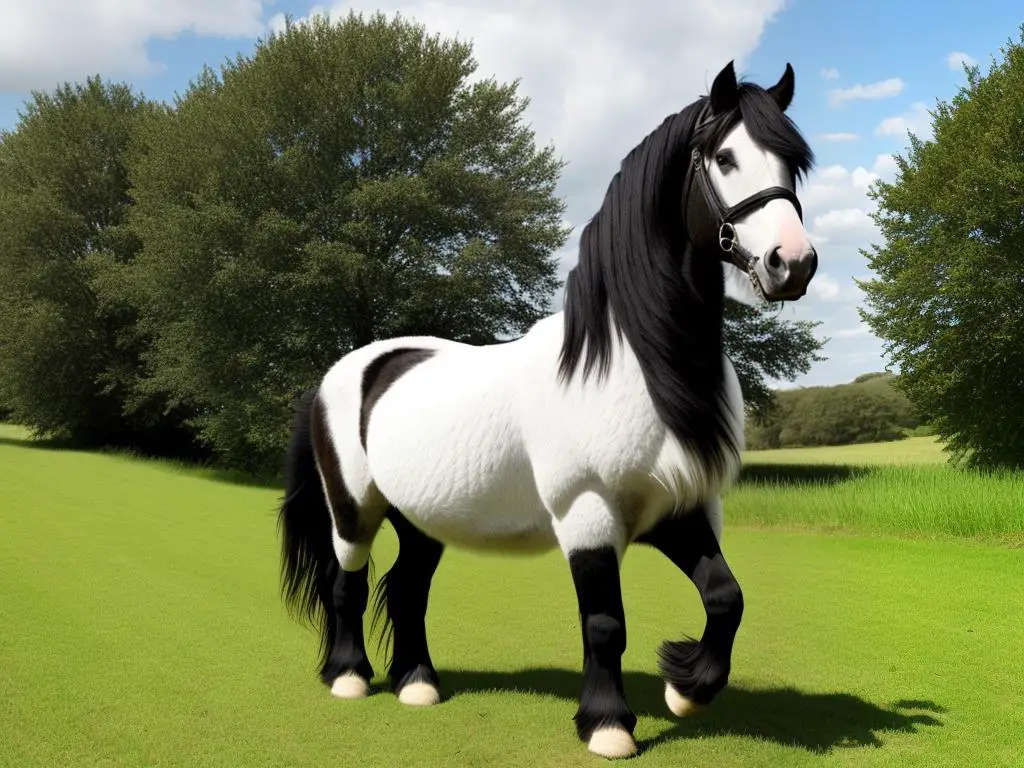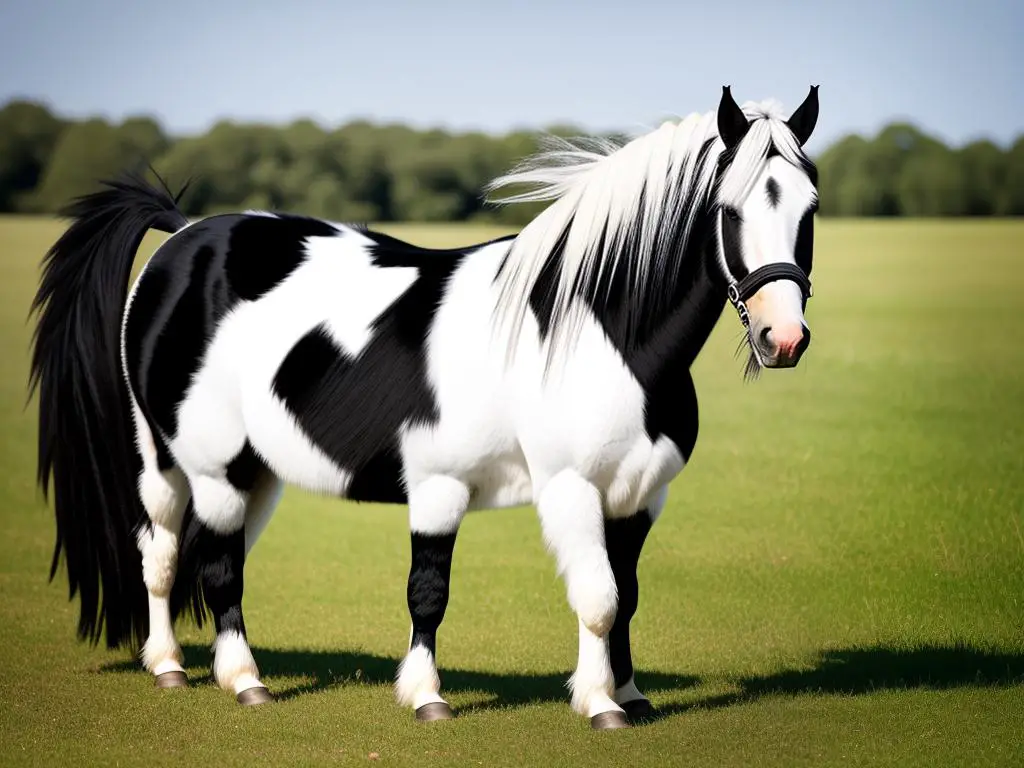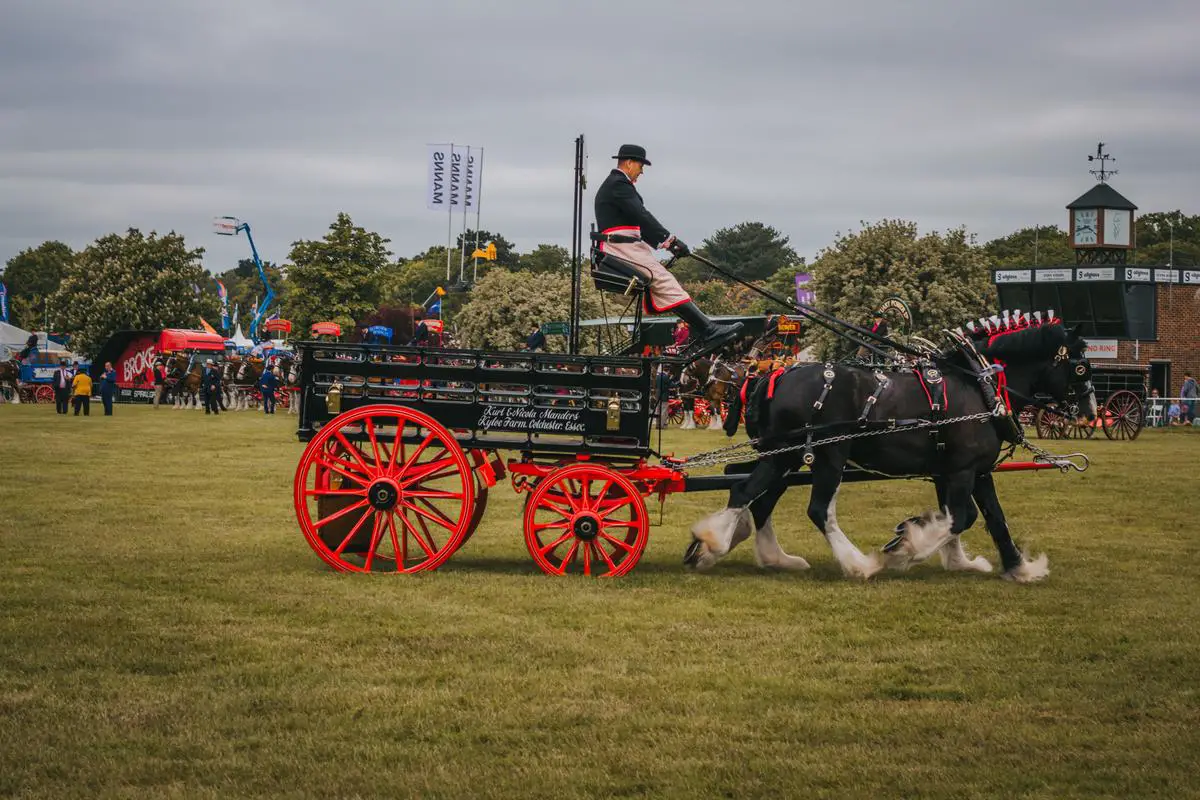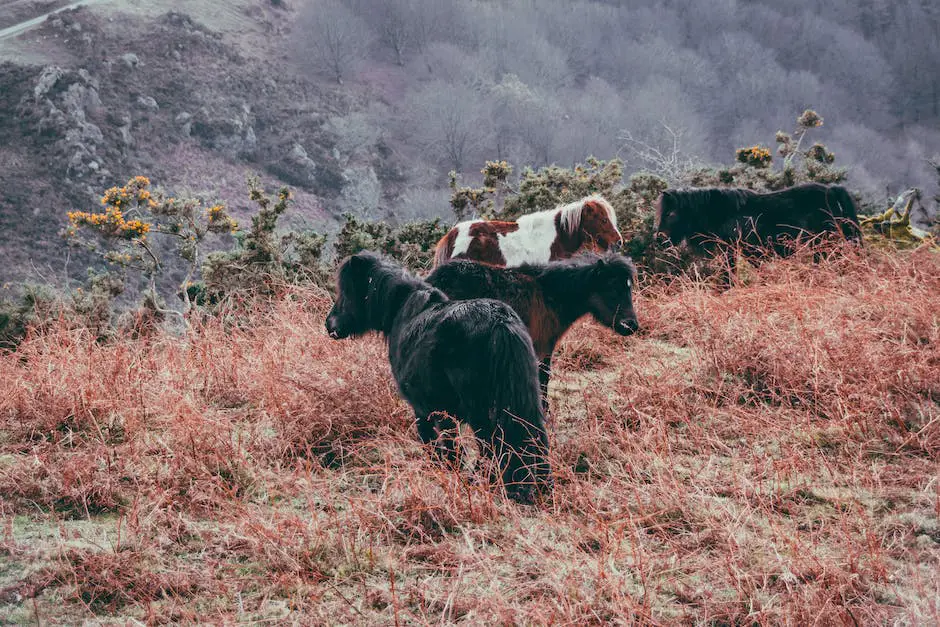For centuries, equine enthusiasts have marveled at the impressive strength and majestic beauty of the Shire Horse and the Gypsy Vanner. Both breeds command attention, with their robust builds and captivating allure. Yet, upon closer look, one begins to discern the distinct characteristics and unique histories that set these incredible horses apart. This detailed exploration seeks to immerse readers in the world of these breeds, providing an in-depth understanding of their histories, physical features, temperaments, and the roles they have played on a global platform. It further delves into a comparative analysis of these breeds and outlines crucial considerations that potential owners should bear in mind when making a choice between these two.
Table of Contents (Horspedia)
Shire Horse: Breed Overview
Shire Horse: Breed Overview
Shire horses, native to the British Isles, have a long and proud history. This breed is believed to have descended from the ‘Great Horse’ that was used as a warhorse in the Middle Ages. First used for farming, the Shire breed was later used for heavy hauling in the industrial revolution. As technology advanced in the 20th century, their numbers began to decrease. However, organizations such as the Shire Horse Society took efforts in preserving this breed, and now they are often seen in shows, parades, and few continue to serve in traditional roles, like plowing and logging.
The Shire horse is distinguished by its size: often standing at over 17 hands high (68 inches) and can weigh up to 2400 pounds. They have broad, muscular bodies, heavy feathering around their legs, and typically come in black, bay, or grey. Shires have a docile, steady temperament, making them suited for a variety of tasks.
Shire Horse and its Global Influence
The Shire breed has notably influenced horse breeding around the world. In particular, their bloodline has been important in the development of other draught breeds, such as the Belgian. Despite their powerful size, Shires are praised for their gentle and willing nature, factors that have made them popular among horse enthusiasts worldwide.
Gypsy Vanner: Breed Overview
The Gypsy Vanner, also known as the ‘Gypsy Cob’ or ‘Irish Tinker Horse’, is a smaller draught horse breed. Developed by the Roma peoples of the United Kingdom and Ireland, Gypsy Vanners were bred to be sturdy yet stylish—capable of pulling colourful Romani wagons during the day, yet gentle and calm enough to be around children at night.
These horses stand about 14 to 16 hands high (56 to 64 inches), and have a heavy bone structure with a lot of ‘feathering’ around their feet, akin to Shire horses. They are mainly recognized by their piebald or skewbald coat colors, but other variations are also present.
Shire Horse vs Gypsy Vanner: An Intriguing Comparison
When unraveling the traits of Shire horses juxtaposed with Gypsy Vanners, several distinct differences are observable. Pertinently, size is the most conspicuous disparity. Shire horses, towering over the Gypsy Vanner, typically exhibit a larger stature. Furthermore, each breed embodies a unique coat color palette: Shires radiating in hues of black, bay, or grey, while Gypsy Vanners sport eye-catching piebald or skewbald coats.
Delving deeper than physical characteristics, the historical scenarios in which these breeds were employed varies significantly. Shire horses, initially harnessed as powerful warhorses, were subsequently utilized for demanding agricultural and industrial tasks. In contrast, Gypsy Vanners, birthed from the customs of the Romani community, were primarily purposed for hauling wagons.
Despite the contrasts, both breeds share the common trait of a gentle and good-natured temperament. Gypsy Vanners are particularly renowned for their placid demeanor, a testament to their dual-role breeding as both workhorse and family companion.
Reflecting on the contemporary context, both these noble breeds have witnessed a revival in popularity spanning beyond their historical roles. Currently, their versatility is showcased in diverse recreational activities, ranging from sophisticated dressage to leisurely trail riding, serving as living testaments to their imprint on human history.

Gypsy Vanner: Breed Overview
Delving Deeper into the Gypsy Vanner Breed
The Gypsy Vanner, alternately referred to as the Irish Cob or Gypsy Horse, boasts a cultural heritage steeped in historical richness. This mesmerizing breed was the innovation of the Romani community in the British Isles, who sought resilient, multifaceted horses to pull their emblematic vardoes and caravans, all while ensuring their gentility around their young ones.
Upon physical appraisal, Gypsy Vanners captivate the audience with their undeniable allure. These mesmeric creatures typically exhibit a height measurement of 13 to 15 hands, their robust structure signaling their tenacity and longevity. Their iconic, feathered legs dramatically enhance their overall grandeur.
The distinct personality of Gypsy Vanners is highly regarded. These equine beings are lauded for their intelligence, tempered with a peaceful free-spiritedness, facilitating cooperative work with humans. This soft-spoken temperament posits them as an incredible choice for riding, particularly for children and equestrian novices.
Transcending their traditional usage, Gypsy Vanners possess a flexible profile in the equestrian realm. They were historically employed as trade horses, but their physical strength harmonized with their amiable temperament renders them capable for driving and dressage. Their distinct, striking look has charmed many, leading to an increased showcase in horse shows and their enlistment in equine-assisted therapeutic programs.
Shire Horse versus Gypsy Vanner
When you consider the Shire Horse and the Gypsy Vanner, both breeds originated for utilitarian work, yet their individual distinctions set them apart. While the Shire Horse is one of the largest horse breeds, standing around 17 to 19 hands tall, it’s renowned for exceptional strength and durability, attributes that aided in their traditional roles, such as farm work and pulling heavy loads.
Despite its imposing size, the Shire Horse has a reputation for being gentle and accommodating, qualities that make it great for various activities, including leisure riding and farm duties. On the other hand, the Gypsy Vanner, with its unique aesthetic beauty and smaller size, has carved a unique space for itself in the equestrian world.
In terms of global impact, both breeds have significantly influenced horse culture. The Shire Horse notably influenced the farming industry, particularly in its native England, where it was widely employed for centuries. In contrast, the Gypsy Vanner has made a remarkable impression in the equestrian world with its distinct beauty and heritage, leading to its rising popularity among horse lovers.
In summary, while the Gypsy Vanner and the Shire Horse share common ground in their temperament and history of labor, each breed possesses distinct qualities that have fostered their separate niches within horse society.

Comparison: Shire Horse vs Gypsy Vanner
Further Comparison: Shire Horse and Gypsy Vanner
Hovering from the United Kingdom, both the Shire horse and the Gypsy Vanner are among the world’s most recognized horse breeds, distinguished for their strength, durability, and trademark aesthetics. Their shared history as draft animals is one of many commonalities, yet they diverge in many key aspects, such as size, color, lifespan, health risks, and their aptness for various roles.
Size
Shire horses are among the largest horse breeds in the world. They can stand anywhere from 16 to 18 hands (64 to 72 inches) at the shoulder. A mature Shire horse can weigh up to 2,200 pounds. On the other hand, Gypsy Vanners are smaller and typically range from 13 to 15 hands (52 to 60 inches) and weigh around 1,000 to 1,500 pounds. Despite the size difference, both breeds are considered heavy draft horses due to their thick and strong builds.
Color
Historically, Shire horses were primarily black, but brown and grey have become more common colors. However, they should not exhibit excessive white markings beyond the face and lower legs. In contrast, Gypsy Vanners often showcase a broad range of colors and patterns, the most distinctive being the piebald (black and white) and skewbald (any color and white). They are also recognized for their long, flowing manes and tails often contrasting with their body colors.
Lifespan and Health Issues
Shire horses typically have a lifespan of 20 to 25 years. Known health issues in this breed include Chronic Progressive Lymphedema, a progressive condition affecting the leg’s skin and underlying tissues. On the other hand, Gypsy Vanners are known for their longevity and can live into their thirties. They generally have fewer health issues, but like most horse breeds, they are prone to Laminitis, a disease resulting from overfeeding.
Suitability to Various Tasks
When it comes to work, both Shire horses and Gypsy Vanners are immensely versatile. Shire horses have traditionally been used in farm work, pulling heavy loads, and even in warfare. Today, they are often seen in promotional and ceremonial activities and competitive events like horse pulling and dressage. Meanwhile, Gypsy Vanners were initially bred by the Romani people of England to pull their caravans in the 19th century. They are known for their calm nature and willingness to work, making them ideal for many equestrian pursuits such as riding, driving, and even therapeutic riding programs.
Conclusion
All things considered, whether it’s the Shire horse or the Gypsy Vanner, there’s no denying the power, grace, and extraordinary history that both types possess. Their remarkable physical capabilities coupled with their adaptability make them favorites among equestrian aficionados as well as those in need of a dependable, stout-hearted workhorse.

Ownership Considerations
Comparing Shire Horses and Gypsy Vanners for Potential Owners
Embarking on horse ownership brings to forefront the important decision of breed selection. Prominent on this list often fall the Shire horse and Gypsy Vanner breeds. Differing in attributes like physical characteristics, disposition, upkeep, cost, and fitness for different applications, these breeds each provide their unique offerings. It’s important that prospective owners carefully consider these factors, especially when making a comparison between the Shire horse and the Gypsy Vanner.
Costs and Relevant Considerations
Major distinctions exist between the Shire and Gypsy Vanner horses in terms of cost. While specific prices vary widely depending on an individual horse’s pedigree, lineage, and other unique factors, Gypsy Vanner horses generally tend to have a higher price range when compared to Shire horses due to their rarity and unique features, particularly their fancy feathering and bold colours. Again, these costs can fluctuate based on the horse’s age, training, temperament, and abilities.
Care and Feeding Requirements
Both the Shire and Gypsy Vanner horses are draft breeds and require similar types of care. They need a diet high in quality forage, along with a balanced protein, vitamin, and mineral intake. Given their size, they often generally consume more food than lighter breeds.
However, the Gypsy Vanner is slightly smaller, and it might be both easier and less expensive to provide for. Yet, their long, thick hair, particularly the “feathers” on their lower legs require regular grooming to prevent infections from developing.
Shire horses, on the other hand, although possessing a long mane and feathers like the Gypsy Vanner, have a slightly less dense coat which can be somewhat easier to manage.
Suitability for Beginners or Experienced Handlers
With respect to beginner or experienced handlers, it will often be the individual horse’s temperament and level of training that will matter most. However, overall, both breeds are known for their docility and calm natures.
Specifically, Shire horses are often renowned for their gentle, willing, and companionable nature, which makes them a good fit for novice handlers. They are cooperative and tolerant, providing a substantial margin of safety to less experienced horse owners.
Gypsy Vanners, on the other hand, were bred to be family horses, and they too are known for their docile, calm, and friendly dispositions, making them suitable for beginners. However, their eye-catching appearance may take a bit more upkeep compared to the Shire, which could be a consideration for a first-time horse owner.
Ideal Environments for Each Breed
Generally, both breeds are adaptable to most climates, as they both originate from regions with diverse weather patterns (Shires from England and Gypsy Vanners from the British Isles). However, due to the luxurious coat of the Gypsy Vanner, care should be taken in extremely hot climates to prevent overheating, and a shaded area or stable should be provided.
Shire horses, on the other hand, are well suited for colder climates due to their heavy body and long, dense coat but can also adapt to warmer areas.
Particular attention needs to be given to the environment wherein they are to be exercised. As both breeds are large draft horses, they should have ample space for movement to maintain their health.

After comprehending the unique particulars of the Shire Horse and the Gypsy Vanner, one gains a deep appreciation for these remarkable breeds. Whether it’s their robust physical presence, the centuries-old history they carry, or the varied roles they have undertaken, every aspect contributes to their exclusive charm. We’ve taken an in-depth look at their characteristics, from size and color to lifespan and health considerations, and provided side-by-side comparisons to help discern the many ways they are alike and unalike. We’ve also laid out key factors for prospective owners, including aspects such as cost, care requirements, and suitability to various handlers and environments. It’s evident that either breed would make a splendid addition to any horse-loving family, provided their specific needs and characteristics are taken into account.
